
This mulch stands out like a sore thumb, and may contain hazardous elements.
(Photo courtesy Julie Moir Messervy)
Like many of you, I fail to understand why so many people consider the bright red-dyed mulch to be the mulch of choice for their home outside. I know that I shouldn’t put down anyone’s taste, but of more concern is the use of mulch that is potentially harmful to oneself and the environment. Some of these red mulches are made from chipped wood that comes from demolished buildings with CCA (Chromated Copper Arsenate) in it, a preservative that contains the carcinogen arsenic. You’ll know it’s safe to buy if the Mulch and Soil Council certifies the mulch you’re interested in.

This brown mulch looks better than the bright mulch pictured above, but it may not be the best solution.
(photo courtesy Julie Moir Messervy)
You’ve all probably heard that, while putting on handsome dark brown, fine-gauged mulch makes your planting beds look well tended and weed-free, it’s not always the best thing to do for your garden. Gardensalive.com posted an excellent article about how wood mulch can both slow the growth of established plants and starve new ones. They recommend using 2” of compost over all your beds to both keep down weeds and feed your plants at the same time.
But the real problem these days is what I see wherever I travel—the mulching of America. Homeowners have come to believe that they don’t need plants anymore; that once the mulch goes down, they’ve created a finished landscape. Wrong! Use mulch as a temporary fix to hold a slope or compost to fill up a planting bed until the shrubs, perennials, or groundcovers have a chance to grow in. Ideally, you won’t need to use mulch at all once your plantings are established.
Look at the progression of a North Carolina front yard from 1) lawn to 2) mulch to 3) a beautiful garden for all to enjoy:



(photos courtesy of Virginia Weiler)
One more thing:please don’t use rubber mulch on your garden. Yes, it’s made from recycled tires, but no, it’s not permanent and has all sorts of toxic chemicals that will leach into your soil. Read Dr. Linda Chalker-Scott’s paper, “The Myth of Rubberized Landscapes,” for details.
-J.M.M.

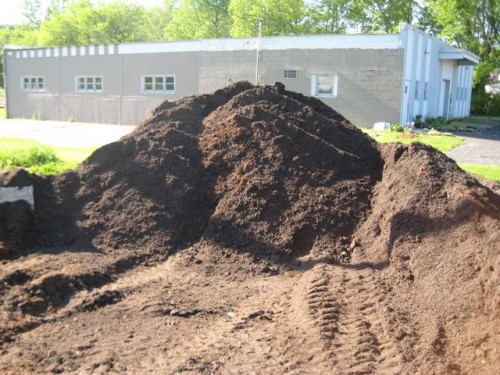
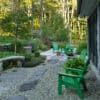
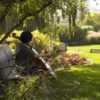
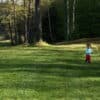

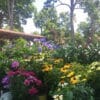
I put my house up for sale and my garden is a victim of exactly the mind set you describe. My 15 year old English country garden had to be mulched this spring with the brown chipped wood mulch for the first time to make it “neat and tidy.” The mulch really has done some damage to favorite plants and is not nearly as effective at keeping down weeds as were the messy leaves I left on the ground from fall. It is so sad to see mulch regarded as a landscape.
Dear Julie:
I couldn’t agree with you more. My suggestion for the next most horrendous landscape faux pas is contractor sidewalks. The paragraphs below are from an article I wrote about my pet peeves re landscaping.
How often, when visiting a client for the first time, do you approach the front door by means of a narrow concrete sidewalk that has only enough width for one person at a time? Keeping in mind the fact that visitors frequently arrive in pairs, don’t you think a sidewalk should be wide enough for two people to walk side by side? That concrete sidewalk is most often stark white although time and the weather may have dimmed the color a bit but why couldn’t the walk be created with tinted concrete that complements the color of the house? Nor does the walk have to be an L-shape composed of two straight lines, one from the driveway and then the perpendicular to the front door. It’s certainly the cheapest method of constructing a sidewalk but far from attractive.
Another problem with such sidewalks is that they are usually set out only a few feet from the house, thus creating very shallow planting beds between the house and the walk. Then plants are arranged like soldiers because there is insufficient space to create a composition. One of the essential elements of composition is layering, i.e.groupings of plants that have different heights, forms, and textures. This type of composition creates interesting landscapes that, hopefully (more later), change with the seasons. When you are given the opportunity to change these beds, usually by ripping out the existing walk, remember to create a shape that echoes or works off of the lines of the house. Also keep in mind that foundation plantings did not always exist. In England of the 1500’s and 1600’s, lawn came all the way up to the house. Foundation plantings came into existence when the foundations of homes were raised. At that time, plantings were used to hide the ugly foundations. Even though such an imperative no longer exists, the tradition has continued.
One of my biggest pet peeves is the belief that because it is spring it is time to prune. People break out the pruning shears and go after all their shrubs trying to turn them into balls and boxes! Save yourself some trouble, and allow plants to grow naturally, they are so much more beautiful when allowed to do what they do! If folks would plant shrubs in the right spaces, and give them room to grow they could enjoy the wonderful, natural, feathery, layered branching (and save themselves some time and effort as well). Some shrubs just aren’t meant to be balls!
Hi Julie, just saw your lectures at the Hardy Plant Study weekend in Victoria BC. They were great; but you know that Music Garden thing? “I would’ve done things a bit differently!” Anyway, my mulch horror story involves a client who insisted that I use the red-cedar mulch on the beds surrounding her suburban house. After much explaining and complaining I complied. It was a very hot, DRY summer and she hadn’t been watering. The postman came by. He was a smoker. I was called after the Fire Deartment had left. No further explanation needed! (No damage done to house). Not so hard to convince new clients about the benefits of compost as a mulch once they’ve heard that tale.
Cheers, Richard
No trees/shrubs/flowers and all lawn! Some people I know (who shall remain nameless) bought a newish house in a suburban development and there wasn’t a single mature tree in the development, just acres of lawn everywhere. I know its cheaper for developers to level everything, but couldn’t they have left one or two trees, or at least planted one or two trees?
And do people really need all that lawn, especially out front? No one plays in their front yards, so why does the landscaping of choice have to be grass and maybe a few Privets or Arborvitae plunked in front of the house?
I don’t see this problem with older homes since trees planted 50 years ago have had time to mature, but when I asked about maybe planting some trees or shrubs, the owner was nearly horrified about messing up his beautiful turf, or bothering with the expense of buying and planting something else.
Sometimes, I might see an owner has decided to plant a windbreak or a privacy screen, so they buy like 20 tiny Arborvitae and line them up in a pathetic little row. Hideous!
I’m not sure this is a landscaping problem or maybe just a reflection of the obsession homeowners have with fitting in/having the perfect lawn.
Hi Steph,Marilyn Elle, Bobbie, Kate, and Richard:
Thanks for adding to the conversation. We appreciate your weight in about your particular pet peeves. Marilyn Elle’s comment that “It is so sad to see mulch regarded as a landscape” perfectly summarizes our first Pet Peeve posting! Bobbie’s comment about contractor front walks were so well put that it became our second Pet Peeve posting. We’ll take up Kate’s Pet Peeve in late winter, before people break out their pruning shears again. Her thought that “Some shrubs just aren’t meant to be balls!” is a great way to begin the post!
Richard, your story about the smoking red mulch provided us with some laughs! Thanks for your good words about the program in Sidney–very fun for me to meet you all. And Steph, you told us a sad story about a neighbor who can’t imagine why anyone would take the trouble or expense to plant even a tree on their perfect lawn.
Clearly, we at JMMDS need to get the word out way further than we are about why and how to have good landscape design. With this blog, the Home Outside book, lectures, and videos, I’m trying hard to rectify some of these problems!
I had never seen the red dye stuff in bulk until we moved to Savannah, from Oregon, for 8 months. We are back in Oregon, near Portland.
In this area, the natural fir and hemlock bark are indispensible to retain moisture and reduce soil compaction. The fine mulches are okay, but tend to erode more, splash and discolor siding, and most arborists know that find compost is not better for trees than coarse mulch.
I’ve never even seen the rubber stuff, but it must be around here somewhere. It’s hard to imagine putting shredded tire scrap remnants around landscaping.